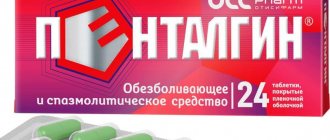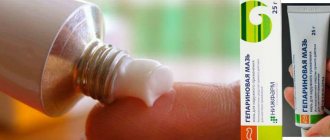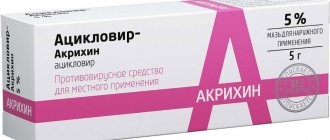Dimetindene-akrikhin 0.1% 50g gel for external use
pharmachologic effect
Antiallergic agent – H1-histamine receptor blocker.
Composition and release form Dimetindene-akrikhin 0.1% 50g gel for external use
Gel – 1 g:
- active ingredient: dimethindene maleate – 1.0 mg;
- excipients: carbomer (type 974 P), disodium edetate, sodium hydroxide, propylene glycol, benzalkonium chloride, purified water.
Gel for external use 0.1%.
5 g, 30 g or 50 g in an aluminum tube, sealed with a membrane, closed with a high-density polyethylene lid. Each tube, along with instructions for use, is placed in a cardboard box.
Description of the dosage form
Colorless, transparent, homogeneous gel.
Directions for use and doses
Externally. The gel is applied to the affected area of the skin 2-4 times a day. In cases of severe itching or widespread skin lesions, simultaneous use of oral forms is recommended.
Pharmacodynamics
Antihistamine, antiallergic and antipruritic agent. H1-histamine receptor blocker, is a competitive histamine antagonist. The drug reduces increased capillary permeability associated with allergic reactions. When applied to the skin, Dimetinden-Akrikhin gel reduces itching and irritation caused by allergic skin reactions. The drug also has a pronounced local anesthetic effect. It also has antikinin and weak anticholinergic effects. When used externally, thanks to the gel base, it has a quick onset of action (within a few minutes) and a slight cooling effect. The maximum effect is after 1-4 hours.
Pharmacokinetics
When used externally, it penetrates well into the skin, systemic bioavailability is 10%.
Indications for use Dimetindene-akrikhin 0.1% 50g gel for external use
Skin itching of various origins (except those associated with cholestasis), for example: itchy dermatoses, eczema, urticaria, insect bites. Sunburn, household and industrial burns (mild).
Contraindications
Hypersensitivity to dimethindene and other components included in the drug, angle-closure glaucoma, prostatic hyperplasia, children under 1 month of age, especially premature infants.
Carefully
Pregnancy I trimester, lactation period.
Application of Dimetindene-akrikhin 0.1% 50g gel for external use during pregnancy and breastfeeding
The use of the drug in the first three months of pregnancy is possible only after consultation with a doctor. In the second and third trimesters of pregnancy, as well as during lactation, Dimetinden-Akrikhin gel should not be used on large areas of the skin, especially in the presence of inflammation or bleeding. Nursing mothers should not apply the drug to the nipples of the mammary glands.
special instructions
In children from 1 month to 2 years, the drug is used after consultation with a doctor. In infants and young children, the drug should not be used on large areas of the skin, especially if there is inflammation or bleeding.
In case of severe itching or if large areas of skin are affected, the drug can be used only after consultation with a doctor.
When using Dimetindene-Akrikhin gel on large areas of the skin, exposure to sunlight should be avoided.
If during the period of using Dimetindene-Akrikhin gel the severity of the symptoms of the disease does not decrease or, on the contrary, intensifies, you should consult a doctor.
Ineffective for itching associated with cholestasis.
The drug contains propylene glycol and benzalkonium chloride, which can cause local allergic reactions.
Impact on the ability to drive vehicles and operate machinery
Does not affect.
Overdose
If a large amount of the drug is accidentally ingested, symptoms characteristic of an overdose of H1-histamine receptor blocker drugs may occur, including depression of the functions of the central nervous system, drowsiness (mainly in adults), stimulation of the functions of the central nervous system, antimuscarinic effects (especially in children) , including increased excitability, ataxia, hallucinations, tonic-clonic seizures, mydriasis, dry mouth, flushing, urinary retention and fever. This may be followed by a drop in blood pressure.
Treatment:
A specific antidote is unknown. The usual emergency measures should be taken: if taken orally, take activated charcoal, saline laxatives; if necessary, take measures to maintain the function of the cardiovascular and respiratory systems. Vasoconstrictors can be used to treat arterial hypotension. Do not exceed the recommended dose of Dimetindene-Akrikhin gel.
In case of accidental overdose, tell your doctor immediately.
Side effects Dimetindene-akrikhin 0.1% 50g gel for external use
Classification of the frequency of occurrence of adverse reactions: very often (≥1/10); often (≥1/100,
Disorders of the skin and subcutaneous tissues:
Uncommon: dry, burning skin.
Very rare (post-registration data): allergic dermatitis, including skin rash, itching.
If any of the side effects indicated in the instructions get worse, or you notice any other side effects not listed in the instructions, tell your doctor.
Drug interactions
There are no known drug interactions for Dimetindene-Akrikhin gel.
Dimetindene drops for oral administration 1 mg/ml fl. 20 ml
Indications
For oral administration: urticaria, hay fever, vasomotor rhinitis, food and drug allergies, angioedema; as an adjuvant in the treatment of anaphylactic reactions and serum sickness; itching due to insect bites, eczema, dermatoses of allergic and non-allergic origin, measles, rubella, chicken pox. Preventive hyposensitizing therapy in patients prone to allergic reactions.
For external use: itchy skin lesions with dermatoses, urticaria, insect bites, as well as minor burns.
pharmachologic effect
Histamine H1 receptor blocker, alkylamine derivative. It has antiallergic, antipruritic and slight anticholinergic effects. It also has a pronounced local anesthetic effect. Causes a mild sedative effect of central origin.
Drug interactions
When used simultaneously with drugs that have a depressant effect on the myocardium, the effect of the latter may be enhanced.
When used simultaneously with tricyclic antidepressants or anticholinergics, the risk of increased intraocular pressure increases.
MAO inhibitors may enhance the anticholinergic and sedative effects of dimethindene.
With simultaneous use, dimethindene enhances the effect of anxiolytics and hypnotics.
With the simultaneous use of ethanol, a slowdown in the reaction rate is observed.
Dosage regimen
Inside. For adults and children over 12 years of age, the recommended daily dose is 3-6 mg, divided into 3 doses. Children aged 1 month to 12 years are prescribed a daily dose of 0.1 mg/kg body weight. The daily dose must be divided into 3 doses.
Externally. Apply to the affected area of skin 2-4 times a day.
In cases of severe itching or widespread skin lesions, simultaneous use of oral forms is recommended.
Contraindications for use
Hypersensitivity to dimethindene; angle-closure glaucoma, urinary disorders (including with prostate hypertrophy), children under 1 month of age (especially in the case of premature birth).
For oral administration: bronchial asthma; I trimester of pregnancy; breastfeeding period.
Use in children
Ingestion. Contraindicated for use in children under 1 month of age (especially in the case of premature birth). Children aged 1 month to 1 year should use the drug only as prescribed by a doctor and if there are indications for the use of H1-histamine receptor blockers, and the recommended doses should not be exceeded.
External use. In children from 1 month to 2 years, dimethindene is used only after consultation with a doctor. In infants and young children, the product should not be used on large areas of skin (especially if it is wet or inflamed).
Restrictions for children
Use with caution
Use in elderly patients
Approved for use in elderly patients according to indications in recommended doses.
Restrictions for elderly patients
Possible use
Use during pregnancy and breastfeeding
Ingestion. Dimetindene is contraindicated for oral use in the first trimester of pregnancy. Use in the II-III trimesters of pregnancy is possible under medical supervision, only if the expected benefit to the mother outweighs the potential risk to the fetus. Use during breastfeeding is contraindicated.
External use. Use in the first trimester of pregnancy is possible only after consultation with a doctor. In the second and third trimesters of pregnancy, as well as during breastfeeding, it should not be used on large areas of the skin, especially in the presence of inflammation or bleeding. Nursing mothers should not apply the product to the nipples of the mammary glands.
Restrictions when breastfeeding
Contraindicated
Restrictions during pregnancy
Use with caution
special instructions
Ingestion. In children aged 1 month to 1 year, the drug should be used only as prescribed by a doctor and if there are indications for the use of H1-histamine receptor blockers, and the recommended doses should not be exceeded.
Impact on the ability to drive vehicles and machinery
During the treatment period, you should not engage in activities that require increased attention or rapid psychomotor reactions.
External use. In children from 1 month to 2 years, dimethindene is used only after consultation with a doctor. In infants and young children, the product should not be used on large areas of skin (especially if it is wet or inflamed). In case of severe itching or if large areas of skin are affected, dimethindene can be used only after consultation with a doctor. When applying dimethindene externally to large areas of skin, avoid exposure to sunlight. Ineffective for itching associated with cholestasis.
Side effect
From the immune system: when taken orally, very rarely - anaphylactoid reactions, including swelling of the face, swelling of the pharynx, rash, muscle spasms and shortness of breath.
From the nervous system: when taken orally - fatigue, drowsiness (especially at the beginning of treatment), nervousness, state of excitement, muscle spasm; rarely - headache, dizziness, anxiety.
From the digestive system: when taken orally, nausea, dry mouth or throat may occur.
Other: when taken orally - swelling; rarely - skin rash; in isolated cases - disorders of the respiratory system.
For external use: rarely - dryness and burning sensation at the site of application, allergic skin reactions.
Dimetindene + Phenylephrine
Dosage form
Nasal drops
Composition per 1 ml:
Active ingredients:
dimethindene maleate – 0.25 mg; phenylephrine hydrochloride (corresponds to 2.5 mg phenylephrine) – 3.045 mg.
Excipients:
anhydrous sodium hydrogen phosphate – 4.4 mg, citric acid monohydrate – 2.6 mg, sorbitol – 35.0 mg, benzalkonium chloride – 0.1 mg, lavender oil – 0.2 mg, purified water – up to 1 ml.
Description
A transparent, colorless to slightly yellow solution with a faint specific odor of lavender.
Pharmacotherapeutic group
Combined antiallergic agent (H1-histamine receptor blocker + alpha-adrenergic agonist).
ATX code:
R01AB01.
Pharmacological properties
Pharmacodynamics
Dimetindene + Phenylephrine is a combination drug containing phenylephrine and dimethindene.
- Phenylephrine is a sympathomimetic agent; when applied topically, it has a moderate vasoconstrictor effect (due to stimulation of alpha1-adrenergic receptors located in the venous vessels of the nasal mucosa), eliminates swelling of the nasal mucosa and its paranasal sinuses.
- Dimetindene is an antiallergic drug - an antagonist of histamine H1 receptors, does not reduce the activity of the ciliated epithelium of the nasal mucosa.
Pharmacokinetics
Dimetindene + Phenylephrine is intended for topical use, and its activity does not depend on the concentration of active substances in the blood plasma.
Indications for use
Acute rhinitis (including runny nose due to colds), allergic rhinitis (including hay fever), vasomotor rhinitis, chronic rhinitis, acute and chronic sinusitis, acute otitis media (as an auxiliary treatment method). Preparation for surgical interventions in the nasal area and elimination of swelling of the nasal mucosa and paranasal sinuses after surgical interventions in this area.
Contraindications
Hypersensitivity to phenylephrine, dimethindene maleate or other components of the drug.
Atrophic rhinitis (including with foul-smelling discharge - ozena). Taking MAO inhibitors (simultaneously or in the previous 14 days).
Angle-closure glaucoma. Children's age up to 1 year.
Carefully
Cardiovascular diseases (arterial hypertension, arrhythmias, generalized atherosclerosis), hyperthyroidism, prostate adenoma, diabetes mellitus, bladder neck obstruction (for example, due to prostatic hypertrophy), epilepsy.
As with any local vasoconstrictor, caution should be exercised when prescribing Dimetindene + Phenylephrine to patients with severe reactions to sympathomimetics, manifested by insomnia, dizziness, tremor, cardiac arrhythmia or increased blood pressure.
Use during pregnancy and breastfeeding
Given the possible systemic vasoconstrictor effect of phenylephrine, Dimetindene + Phenylephrine is not recommended for use during pregnancy and lactation.
Directions for use and doses
Intranasally.
Children under 1 year of age: contraindicated.
Children aged 1 to 6 years (under adult supervision): 1-2 drops in each nasal passage 3-4 times a day.
Children aged 6 to 12 years (under adult supervision) 3-4 drops in each nasal passage 3-4 times a day.
Adolescents over 12 years of age and adults: 3-4 drops in each nasal passage 3-4 times a day.
Before use, it is recommended to thoroughly clean the nasal passages; instilled into the nose with the head thrown back. This head position is maintained for several minutes.
The drug should not be used continuously for more than 7 days. If symptoms persist, you should consult your doctor.
Side effect
Classification of the incidence of side effects according to the recommendations of the World Health Organization (WHO):
- Very often > 1/10;
- Often >1/100 to <1/10;
- Uncommon > 1/1000 to < 1/100;
- Rarely > 1/10000 to < 1/1000;
- Very rare <1/10000, including isolated reports;
From the respiratory system :
Rarely: discomfort in the nose, dry nose, nosebleeds.
Local reactions:
Rarely: burning in the area of application.
If any of the side effects indicated in the instructions get worse, or you notice any other side effects not listed in the instructions, tell your doctor.
Overdose
An overdose of Dimetindene + Phenylephrine can cause sympathomimetic effects, for example, rapid heartbeat, premature contraction of the ventricles of the heart, headache in the back of the head, tremor, fatigue, increased blood pressure, emotional agitation, insomnia, pale skin.
The drug may also cause mild sedation, dizziness, stomach pain, nausea, and vomiting.
Treatment:
the use of activated carbon, laxatives in young children; in adults and children over 6 years old, take large amounts of fluid. There is no specific antidote.
High blood pressure caused by phenylephrine can be treated with alpha-blockers.
Interaction with other drugs
Phenylephrine (as well as other vasoconstrictors) is contraindicated in patients currently receiving MAO inhibitors or who have received them within the previous 2 weeks.
The drug should not be prescribed simultaneously with tri- and tetracyclic antidepressants, beta-blockers.
special instructions
Dimetindene + Phenylephrine should not be used continuously for more than 7 days without consulting a doctor. Prolonged or excessive use of the drug can cause tachyphylaxis and the “ricochet” effect associated with the re-development of nasal congestion (rhinitis medicamentosa), leading to the development of a systemic vasoconstrictor effect.
Do not exceed the recommended doses of Dimetindene + Phenylephrine! Otherwise, manifestations of the systemic effect of the drug may develop, especially in children and elderly patients.
For children under 6 years of age, only nasal drops are used.
Dimetindene + Phenylephrine does not have a sedative effect (does not affect the speed of psychomotor reactions).
The effect of the drug on the ability to drive vehicles and machinery
Does not affect.
Release form
Nasal drops (0.25 mg + 2.5 mg)/ml.
10, 15, 20, 30, 40 or 50 ml of the drug in a dark glass bottle or in a polymer bottle made of high-density polyethylene or in a polyethylene terephthalate bottle with a polyethylene dropper and a screw cap made of polypropylene with or without first opening control or sealed with a stopper - dropper and a plastic screw cap or with a dropper plug (a dropper in the form of a plastic divider), with/without a plastic screw cap and a first opening ring or equipped with a plastic divider, sealed with a plastic cap with/without a first opening ring
A label made of writing or label paper, or a self-adhesive label, is attached to each bottle.
Each bottle, together with instructions for medical use, is placed in a pack of boxed cardboard for consumer packaging or chrome-ersatz cardboard.
Storage conditions
At a temperature not exceeding 30 °C.
Keep out of the reach of children.
Best before date
3 years.
Do not use after expiration date.
Vacation conditions
Available without a prescription.





